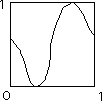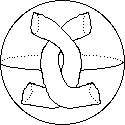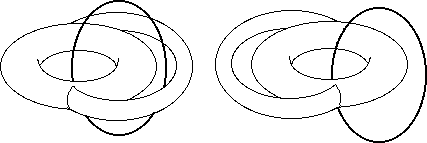For this particular sans-serif font A
 R, C
R, C  G
G  I
I  J
J  L
L  M
M  N
N  S
S  U
U  V
V  W
W  Z, D
Z, D  O, E
O, E  F
F  T
T  Y, H
Y, H  K and the rest (B, P, Q, X) are distinct.
K and the rest (B, P, Q, X) are distinct.
Regarding the letters as having finite thickness gives some more homeomorphisms. For example P  O.
O.
So one gets A  D
D  O
O  P
P  Q
Q  R, B on its own and all the rest homeomorphic to one another.
R, B on its own and all the rest homeomorphic to one another.
Note that the equivalence classes are distinguished by the "number of holes".
Making the letters 3-dimensional does not produce any further homeomorphisms.
The same map works for the finite open intervals also.
The map x  tan(x) maps the finite open interval (-p/2, p/2) to the whole line R in a bijective way with the continuous inverse y
tan(x) maps the finite open interval (-p/2, p/2) to the whole line R in a bijective way with the continuous inverse y  tan-1(y).
tan-1(y).
The same map shows that any open interval of the form (a,  ) or (-
) or (- , b) is homeomorphic to a subinterval of (-p/2, p/2).
, b) is homeomorphic to a subinterval of (-p/2, p/2).
Hence any open intervals are homeomorphic to finite open intervals and hence to each other.
Similar methods show that all half-open intervals are homeomorphic to one another.
 Here is a suitable map. Note that it is not one-one.
Here is a suitable map. Note that it is not one-one.Similarly, the sine function maps the open interval (-
 ,
,  ) to the closed interval [-1, 1].
) to the closed interval [-1, 1].
In fact one cannot find a continuous map from the interval [0, 1] onto (0, 1) but that is hard to prove. You will see a proof later.
Think of the two-holed torus as made by adding a tube to a one-holed torus. Swing this round as shown below to see that the two configurations can be deformed into one another.

